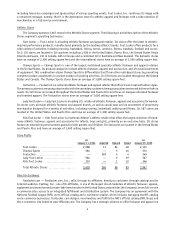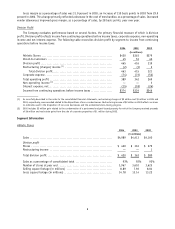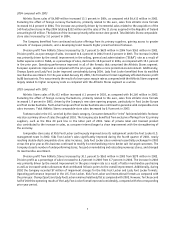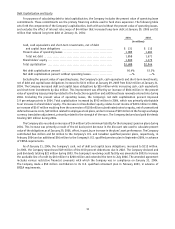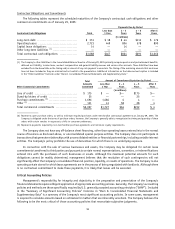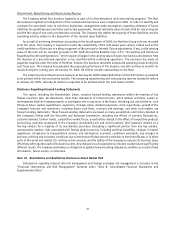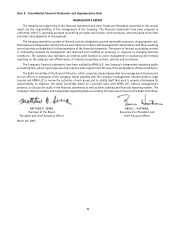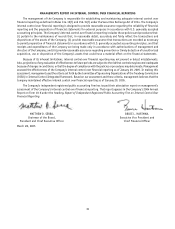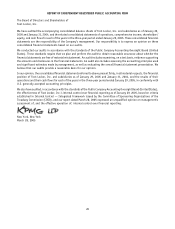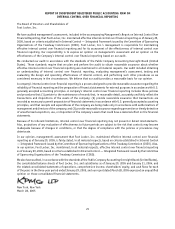Foot Locker 2004 Annual Report Download - page 27
Download and view the complete annual report
Please find page 27 of the 2004 Foot Locker annual report below. You can navigate through the pages in the report by either clicking on the pages listed below, or by using the keyword search tool below to find specific information within the annual report.
Liquidity and Capital Resources
Liquidity
Generally, the Company’s primary source of cash has been from operations. The Company usually finances real estate
with operating leases. The principal uses of cash have been to finance inventory requirements, capital expenditures related
to store openings, store remodelings and management information systems, and to fund other general working capital
requirements.
Management believes operating cash flows and current credit facilities will be adequate to finance its working capital
requirements, to make scheduled pension contributions for the Company’s retirement plans, to fund quarterly dividend
payments, to make scheduled debt repayments, and to support the development of its short-term and long-term operating
strategies. The Company expects to contribute an additional $22 million to its U.S. and Canadian qualified pension plans
during fiscal 2005, of which $19 million was made on February 4, 2005. Planned capital expenditures for 2005 are $165
million, of which $143 million relates to new store openings and modernizations of existing stores and $22 million reflects
the development of information systems and other support facilities. In addition, planned lease acquisition costs are $5
million and primarily relate to the Company’s operations in Europe. The Company has the ability to revise and reschedule
the anticipated capital expenditure program, should the Company’s financial position require it.
Maintaining access to merchandise that the Company considers appropriate for its business may be subject to the
policies and practices of its key vendors. Therefore, the Company believes that it is critical to continue to maintain
satisfactory relationships with its key vendors. The Company purchased approximately 74 percent in 2004 and 73 percent
in 2003 of its merchandise from its top five vendors, in each respective year, and expects to continue to obtain a significant
percentage of its athletic product from these vendors in future periods. Of that amount, approximately 45 percent in 2004
and 40 percent in 2003 was purchased from one vendor — Nike, Inc. (“Nike”) — and 13 percent and 14 percent from
another in 2004 and 2003, respectively.
Any materially adverse change in customer demand, fashion trends, competitive market forces or customer
acceptance of the Company’s merchandise mix and retail locations, uncertainties related to the effect of competitive
products and pricing, the Company’s reliance on a few key vendors for a significant portion of its merchandise purchases,
risks associated with foreign global sourcing or economic conditions worldwide could affect the ability of the Company
to continue to fund its needs from business operations.
Cash Flow
Operating activities from continuing operations provided cash of $289 million in 2004 as compared with $264 million
in 2003. These amounts reflect income from continuing operations adjusted for non-cash items and working capital
changes. The net increase is primarily related to the increase in net income as compared with the prior year, offset in
part by an additional $56 million in pension contributions and increased working capital usage. Merchandise inventories
increased by $120 million to support the recent acquisitions, offset by an increase in accounts payable. The change in
other, net primarily reflects a prepaid income tax that represents an overpayment of tax which the Company will apply
to its 2005 payments.
Operating activities from continuing operations provided cash of $264 million in 2003 as compared with $347 million
in 2002. The decrease was primarily the result of a $50 million pension contribution and increased working capital, partially
offset by increased income from continuing operations. Net income increased by $54 million in 2003. Working capital
usage included higher net cash outflow for merchandise inventories in 2003 as compared with 2002 and the Company
increased its inventory position to accommodate anticipated sales in 2004. The decrease in income taxes payable was
attributable to increased payments made during 2003. The Company received a refund of tax and interest of $13 million
during the fourth quarter of 2003.
Net cash used in investing activities of the Company’s continuing operations was $424 million in 2004 compared
with $265 million in 2003. During 2004, the Company paid $226 million for the purchase of 349 Footaction stores from
Footstar, Inc. and paid e13 million (approximately $17 million, of which $1 million remains to be paid) for the purchase
of 11 stores in the Republic of Ireland. The Company’s purchase of short-term investments, net of sales, increased by $9
million in 2004 as compared with an increase of $106 million in 2003. Capital expenditures of $156 million in 2004 and
$144 million in 2003 primarily related to store remodelings and new stores. Lease acquisition costs, primarily to secure
and extend leases for prime locations in Europe, were $17 million and $15 million in 2004 and 2003, respectively.
11





